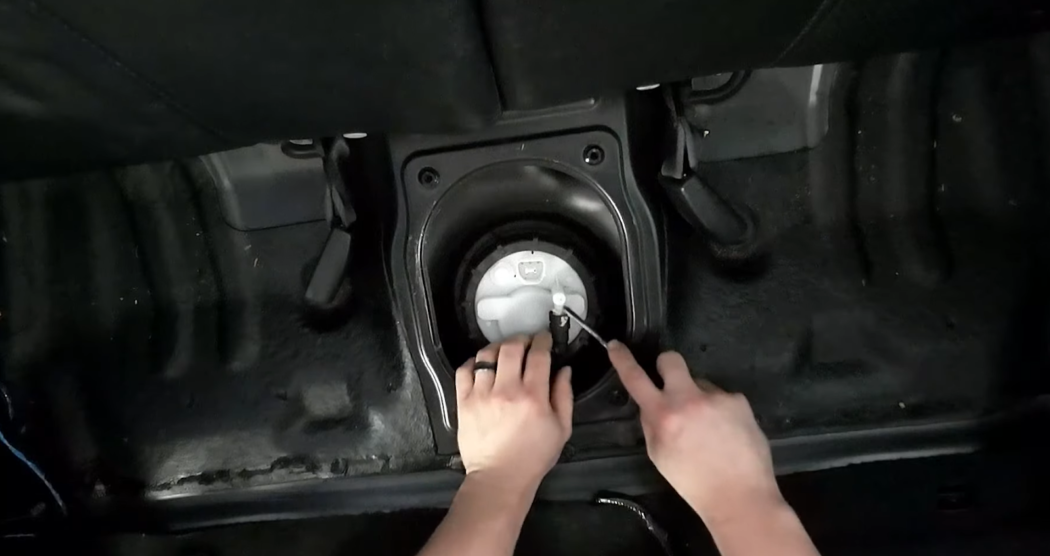
Alt: a man with notes and pen looking at the opened car body
If you own a vehicle equipped with a 7.3 Powerstroke engine, chances are you’ve come across the P1211 code. This code is among the most frequently encountered error codes in vehicles featuring this particular engine. However, uncovering the root cause of this code and devising effective solutions can demand a significant investment of time and effort.
So, what exactly does the P1211 code signify, and how can you address it?
The appearance of the P1211 code on a 7.3 Powerstroke engine points to an issue within the Injection Control Pressure (ICP) system. Specifically, it indicates a potential problem with the fuel pressure, which could be either excessively low or high, thereby affecting the vehicle’s operational efficiency. To successfully rectify this code, several actions can be taken, including changing the engine oil, repairing the Inlet Pressure Regulator (IPR) valve, or opting to replace either the ICP sensor or the fuel pump itself.
Within the confines of this article, I will delve into a comprehensive exploration of the P1211 code as it pertains to 7.3 Powerstroke engines. My aim is to facilitate your grasp of the code’s underlying implications and to offer insights into potential remedies. Without further ado, let’s embark on this enlightening journey.
P1211 Code on 7.3 Powerstroke: What It Indicates
At times, your vehicle might unexpectedly display diagnostic trouble codes (DTCs), indicating underlying issues within its systems. Addressing these codes promptly becomes paramount, as they seldom emerge without significant underlying causes.
Of special concern is the appearance of the P1211 error code, demanding immediate attention. This code serves as an indicator of potential faults within the injection pressure regulator (IPR) or the high-pressure oil pump (HPOP). Given that fuel pressure irregularities could have severe repercussions if left unchecked, disregarding the P1211 error code is inadvisable. It’s a signal you can’t afford to overlook.
P1211 Code on 7.3 Powerstroke: 9 Effective Solutions
When confronted with the P1211 code on a 7.3 Powerstroke engine, a range of effective solutions can be employed to rectify the issue:
Step 1: ICP Sensor Replacement
The ICP sensor plays a vital role in maintaining the optimal performance of your engine. It monitors the fuel pressure coursing through the injectors as it’s delivered to the combustion chamber. This monitoring process, controlled by the IPR (Inlet Pressure Regulator), ensures precise fuel pressure adjustments to keep the engine operating efficiently.
Located at the back of the engine, beneath the turbo and near the firewall, the ICP sensor appears as a small black device with two protruding wires.
A malfunctioning ICP sensor can lead to a host of operational issues. This emphasizes the importance of recognizing potential signs indicating diminishing fuel pressure.
To assess if the ICP sensor is indeed the culprit, carry out a test by disconnecting it and starting the engine. If the engine fails to initiate, it’s likely the sensor needs replacement.
Here’s a quick five-step process for ICP sensor replacement:
- Gently disconnect the electrical connector linked to the sensor;
- Carefully remove the existing ICP sensor;
- Apply a dab of engine oil to the new sensor before installing it;
- Securely tighten the new sensor using an appropriate wrench;
- Reattach the electrical connector and start the engine.
Following these steps, observe whether the P1211 code persists. If it does, consider inspecting the IPR valve for further diagnosis.
Step 2: Replacing the IPR Valve
An erroneous IPR valve is another potential culprit behind the P1211 code manifestation. Operating as a regulator, the IPR valve exercises control over the fuel pressure within the fuel injectors. Given the close interrelation between these components, fuel injector glitches often mirror IPR valve malfunctions.
One method to distinguish between the two problematic parts is by examining your vehicle’s exhaust emissions. Flawed injectors tend to reveal themselves through the emergence of white smoke. This phenomenon ranks among the primary triggers of white smoke seen in diesel engines.
On a divergent note, a malfunctioning IPR valve disrupts fuel pressure equilibrium, resulting in excessive or insufficient pressure. This imbalance can lead to engine instability or even stalling. However, as a defective IPR valve isn’t the sole cause of engine stalling or rough operation in diesel engines, it’s wise to subject it to a meticulous inspection, preferably conducted by a professional, to ascertain its condition definitively.
Should the IPR valve emerge as the source of the problem, the resolution lies in its replacement to effectively eliminate the persistent P1211 code.
Step 3: Fine-Tuning Fuel Pressure
Alt: opened car body with its components
In the realm of troubleshooting the P1211 code, there are occasions when the solution is elegantly uncomplicated—enter the process of fine-tuning the fuel pressure. This error code, which can trigger unwelcome warnings, may arise from imbalances in fuel pressure, either skewed towards the excessively high or the unusually low end of the spectrum.
To appraise whether this fuel pressure anomaly plays a pivotal role in your vehicle’s predicament, it necessitates a meticulous examination of the fuel pressure parameters. Armed with this information, the subsequent step involves the critical task of making precise adjustments to the fuel pressure settings. By ensuring that the fuel pressure aligns harmoniously with the engine’s requirements, you can effectively eliminate the root cause of the P1211 code, restoring smooth functionality to your vehicle’s powertrain.
Remember, this method not only addresses the error at hand but also contributes to the overall health and performance of your vehicle’s engine. Therefore, if confronted with the P1211 code, don’t underestimate the potential impact of fine-tuning the fuel pressure—it might just be the remedy your vehicle requires for a seamless driving experience.
Step 4: Analyzing the Wiring Harness
In the intricate world of automotive diagnostics, the enigmatic P1211 code can also emerge as a consequence of an ailing wiring harness. This common issue serves as a reminder that the complexities of modern vehicles extend beyond the mechanical realm into the intricate web of electrical connections.
The wiring harness, residing beneath the dashboard on the driver’s side, appears as a substantial black conduit brimming with numerous wires interconnected within.
Your task involves a meticulous assessment of this vital harness, ensuring its wires remain securely connected and unblemished. Here’s a step-by-step guide to navigate this process:
- Begin by disconnecting the vehicle’s battery to ensure safety during your inspection;
- Carefully remove the existing harness and conduct a thorough examination, scrutinizing for any signs of wear or damage;
- If you uncover any compromised wires, it’s prudent to replace the harness to restore optimal functionality;
- With the replacement in place, reconnect the battery and initiate the engine.
Should your scrutiny yield no visible issues, consider initiating a code reset by disconnecting the battery for a brief period—usually a few minutes.
However, should the persistent presence of the P1211 code persist, the next logical step would be directing your attention toward the EGR valve, as it unravels the subsequent layer of potential solutions to the perplexing code puzzle.
Step 5: Cleansing the EGR Valve
The exhaust gas recirculation (EGR) valve plays a pivotal role in safeguarding your engine’s efficient operation by preventing the interference of exhaust gases. When functioning optimally, this valve contributes to the reduction of harmful emissions.
As time progresses, carbon particulates accumulate within the EGR valve, gradually obstructing the movement of its plunger. This accumulation can lead to scenarios where the valve either remains closed or becomes stuck in the open position.
A blocked EGR valve can trigger the emergence of the persistent P1211 code. If this scenario resonates with your situation, it may be high time to initiate a thorough cleaning regimen for your EGR valve. Here’s a step-by-step guide to guide you through the process:
- Position your vehicle on a level surface to ensure stability during the procedure;
- Power off the engine to create a safe working environment;
- Disconnect the negative terminal cable of the battery to prevent any electrical complications;
- Remove the EGR valve, a process that might involve unplugging the electrical connector, unscrewing the mounting bolts, and detaching the gasket;
- Employ a valve cleaner to meticulously cleanse the EGR valve and its associated components. If you’re in need of a recommended cleaner, consider the Liqui Moly 2001 Valve Clean, readily available on platforms like Amazon. Renowned for its versatility, this cleaner has the potential to extend your vehicle’s overall service life;
- Reinstall the valve cover and proceed to reconnect the battery cable;
- Kickstart the engine and conduct a leak check for added assurance.
And there you have it! Investing a few minutes to cleanse your EGR valve can translate into valuable time and cost savings in the long run. By embracing this straightforward task, you’re not only contributing to your engine’s seamless functionality but also taking proactive steps to thwart potentially expensive repairs down the road.
Step 6: Refresh the Engine Oil
In the quest to resolve the lingering p1211 code in your vehicle, a fundamental approach worth considering is changing the engine oil.
Despite its apparent simplicity, the act of altering the engine oil holds substantial value. This straightforward maintenance task is one that many individuals can undertake within the comfort of their own homes.
The process involves just a few steps:
- Draining the existing oil from the engine;
- Introducing fresh oil into the engine;
- Installing a new oil filter.
Ideally, integrating the alteration of your car’s engine oil into its regular maintenance routine is a prudent practice. You might be familiar with the general guideline of changing the oil after a set number of miles, but it’s advisable to consult your vehicle’s manual for the specific recommended intervals between oil changes, as suggested by Consumer Reports.
Now, what if the engine oil change yields no positive outcomes? In such a scenario, it might be an opportune time to contemplate replacing the fuel pump, potentially delving deeper into the intricacies of your vehicle’s mechanical system to find the optimal solution.
Step 7: Upgrading the Fuel Pump

Alt: hands with ring on the finger repairing fuel pump of the car
The telltale signs of a deteriorating fuel pump encompass a range of troublesome issues. Your vehicle might exhibit hesitation, stall unexpectedly, or require substantial effort to initiate ignition.
It’s essential to recognize that inadequate fuel pressure can readily translate into the appearance of the P1211 code. If this scenario resonates with your situation, the only viable course of action is to proceed with the replacement of the fuel pump—an imperative measure to rectify the prevailing code and restore your vehicle’s optimal functionality.
Beyond resolving the P1211 code, investing in a new fuel pump also offers a broader spectrum of benefits. From bolstering engine performance to ensuring consistent fuel delivery, the fuel pump plays an indispensable role in the intricate orchestration of your vehicle’s mechanical processes.
Step 8: Resolving Issues with a Defective HPOP
The repercussions of a compromised High-Pressure Oil Pump (HPOP) extend far beyond mere inconvenience. Engine stall, potential damage, diminished performance, and elevated fuel consumption all loom as potential consequences.
Should suspicions arise regarding the state of your HPOP, it’s prudent to promptly seek the expertise of a qualified mechanic. While enlisting professional assistance might entail an additional financial commitment, the dividends in terms of preserving your engine’s well-being and optimizing its performance make the endeavor exceedingly worthwhile. Don’t hesitate to invest in the care and attention your vehicle deserves.
Step 9: Installing a New PCM
If you’ve diligently applied all the aforementioned remedies without success in eliminating the stubborn P1211 code, it might be an indication that the underlying issue lies with a malfunctioning Power Control Module (PCM). Essentially the car’s controller, the PCM functions as its central nervous system, orchestrating operations and dictating behavior.
A compromised PCM can potentially trigger an array of error codes, spanning from P1211 to P0600 through P0606. Given the pivotal role it plays in your vehicle’s performance, addressing this concern mandates timely replacement upon the detection of any of these error codes.
However, the process of replacing the PCM is inherently intricate and typically falls beyond the scope of expertise for most individuals. Unless you boast a background as an experienced mechanic, entrusting this task to seasoned professionals is a judicious choice.
In your involvement concerning PCM replacement, certain pivotal factors warrant your attention:
- Compatibility: Ensure the new PCM aligns seamlessly with your vehicle’s engine specifications;
- Customization: Verify that the PCM is programmed to cater to your car’s specific make and model;
- Software Update: Confirm that the PCM is equipped with the latest software iteration, securing optimal functionality.
Conclusion
If your 7.3 Powerstroke triggers a P1211 code, there’s no need to fret. This code serves as an indicator that your engine requires improved efficiency, and often, the solution is as straightforward as replacing the IPR valve.
However, should the issue persist, consider the following steps:
- Swap out the ICP sensor;
- Fine-tune the fuel pressure;
- Scrutinize the wiring harness;
- Perform a thorough EGR valve cleaning;
- Refresh the engine oil;
- Upgrade the fuel pump;
- Address HPOP concerns;
- Contemplate PCM replacement.
With these potential fixes at your disposal, you’re well-equipped to resolve the issue and swiftly restore your engine to optimal performance.











